Hospitality Consumer Behaviour: Insights and Marketing Strategies
VerifiedAdded on 2023/01/06
|10
|3184
|24
Report
AI Summary
This report provides an in-depth analysis of consumer behavior within the hospitality industry, focusing on the consumer decision-making process, particularly within the context of Butlin's, a chain of seaside resorts. It explores the stages of the consumer journey, from need recognition to post-purchase behavior, and emphasizes the importance of mapping the consumer path for effective marketing. The report contrasts B2C and B2B hospitality decision-making, highlighting differences in customer relationships and marketing strategies. Various market research approaches and methods are discussed, including telephone interviews, the Pareto Principle, surveys, and observation techniques, and how these methods are used to understand consumer behavior. The influence of marketers on consumer decision-making at different stages is examined, along with recommendations for effective marketing strategies. The report underscores the complexity of consumer behavior and the need for adaptable marketing strategies to meet the diverse needs of customers.
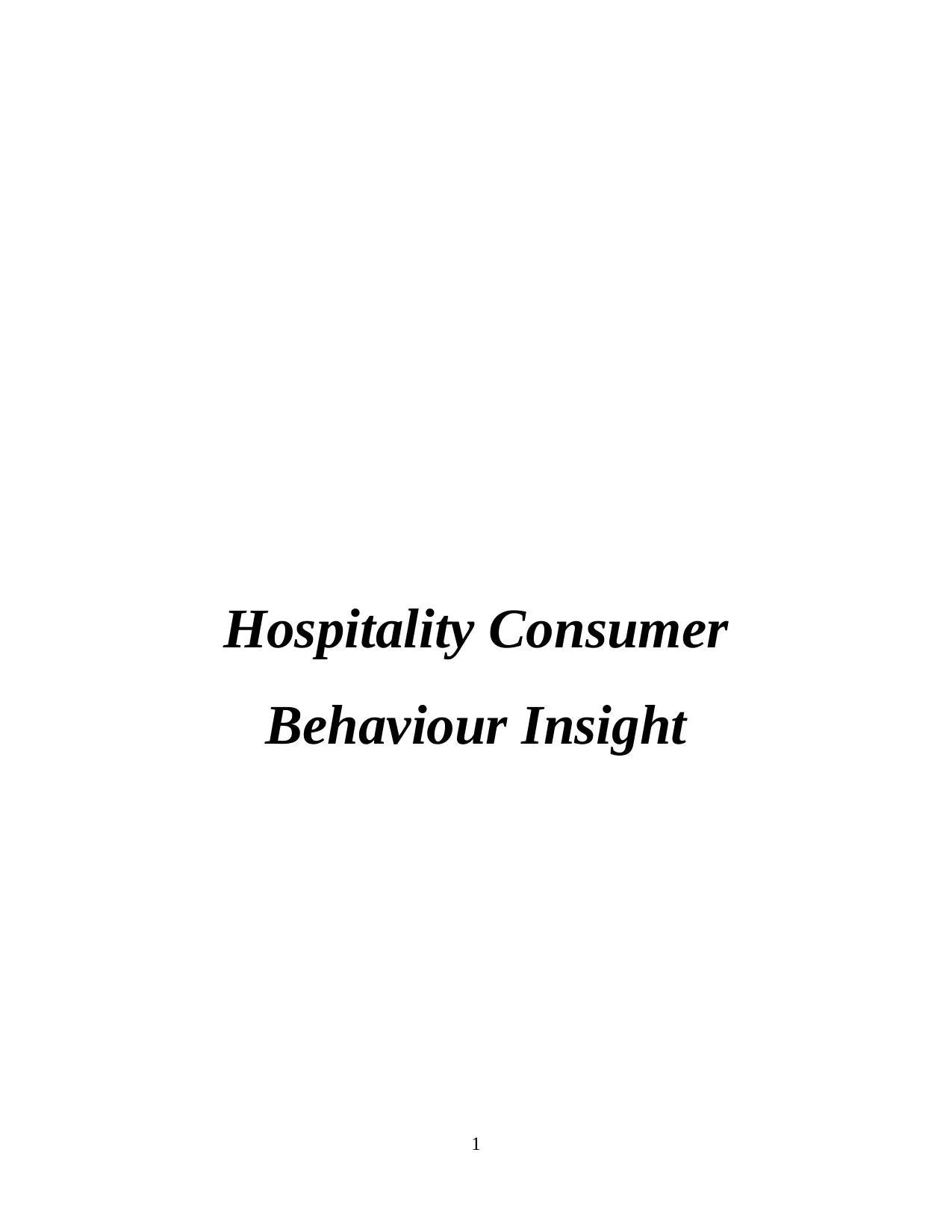
Hospitality Consumer
Behaviour Insight
1
Behaviour Insight
1
Paraphrase This Document
Need a fresh take? Get an instant paraphrase of this document with our AI Paraphraser
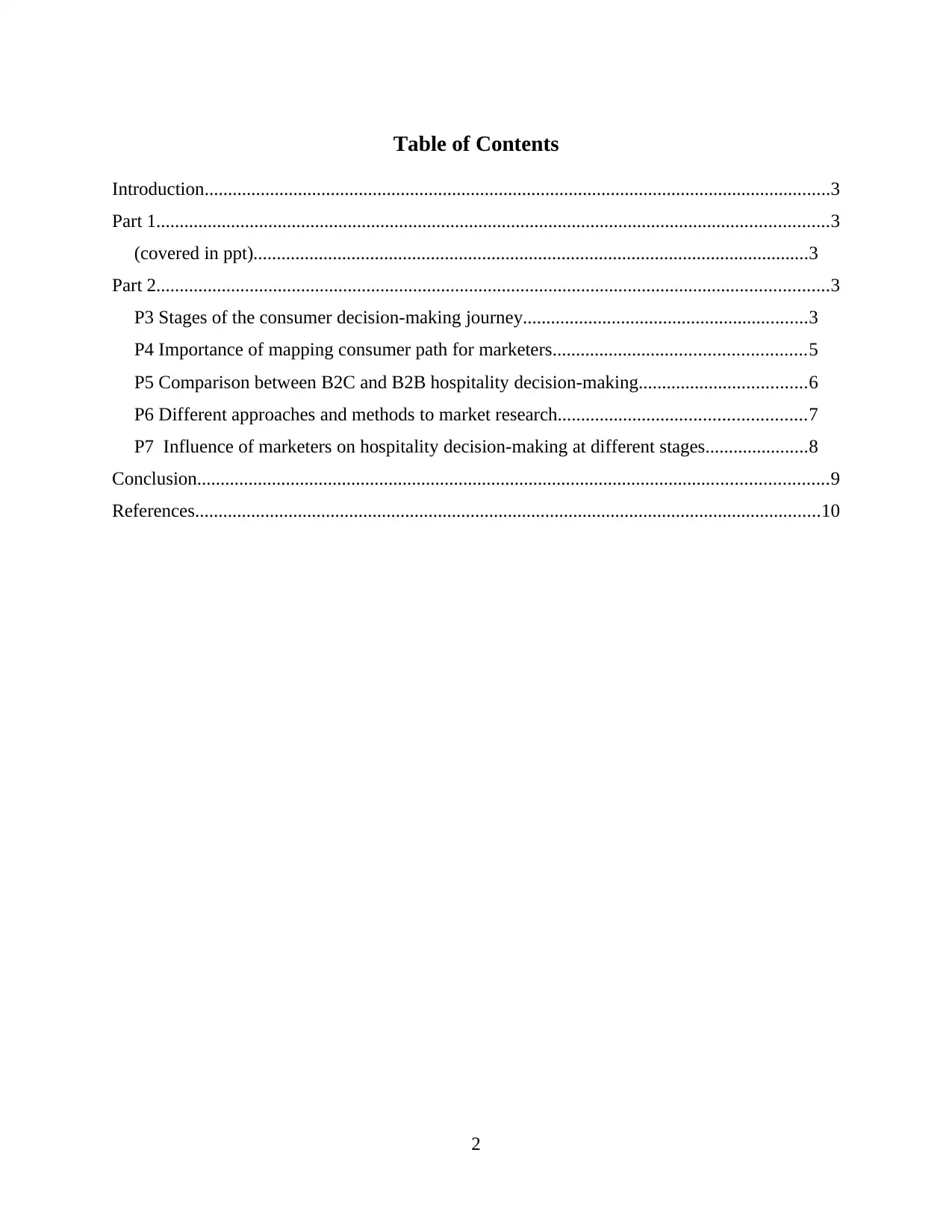
Table of Contents
Introduction......................................................................................................................................3
Part 1................................................................................................................................................3
(covered in ppt).......................................................................................................................3
Part 2................................................................................................................................................3
P3 Stages of the consumer decision-making journey.............................................................3
P4 Importance of mapping consumer path for marketers......................................................5
P5 Comparison between B2C and B2B hospitality decision-making....................................6
P6 Different approaches and methods to market research.....................................................7
P7 Influence of marketers on hospitality decision-making at different stages......................8
Conclusion.......................................................................................................................................9
References......................................................................................................................................10
2
Introduction......................................................................................................................................3
Part 1................................................................................................................................................3
(covered in ppt).......................................................................................................................3
Part 2................................................................................................................................................3
P3 Stages of the consumer decision-making journey.............................................................3
P4 Importance of mapping consumer path for marketers......................................................5
P5 Comparison between B2C and B2B hospitality decision-making....................................6
P6 Different approaches and methods to market research.....................................................7
P7 Influence of marketers on hospitality decision-making at different stages......................8
Conclusion.......................................................................................................................................9
References......................................................................................................................................10
2
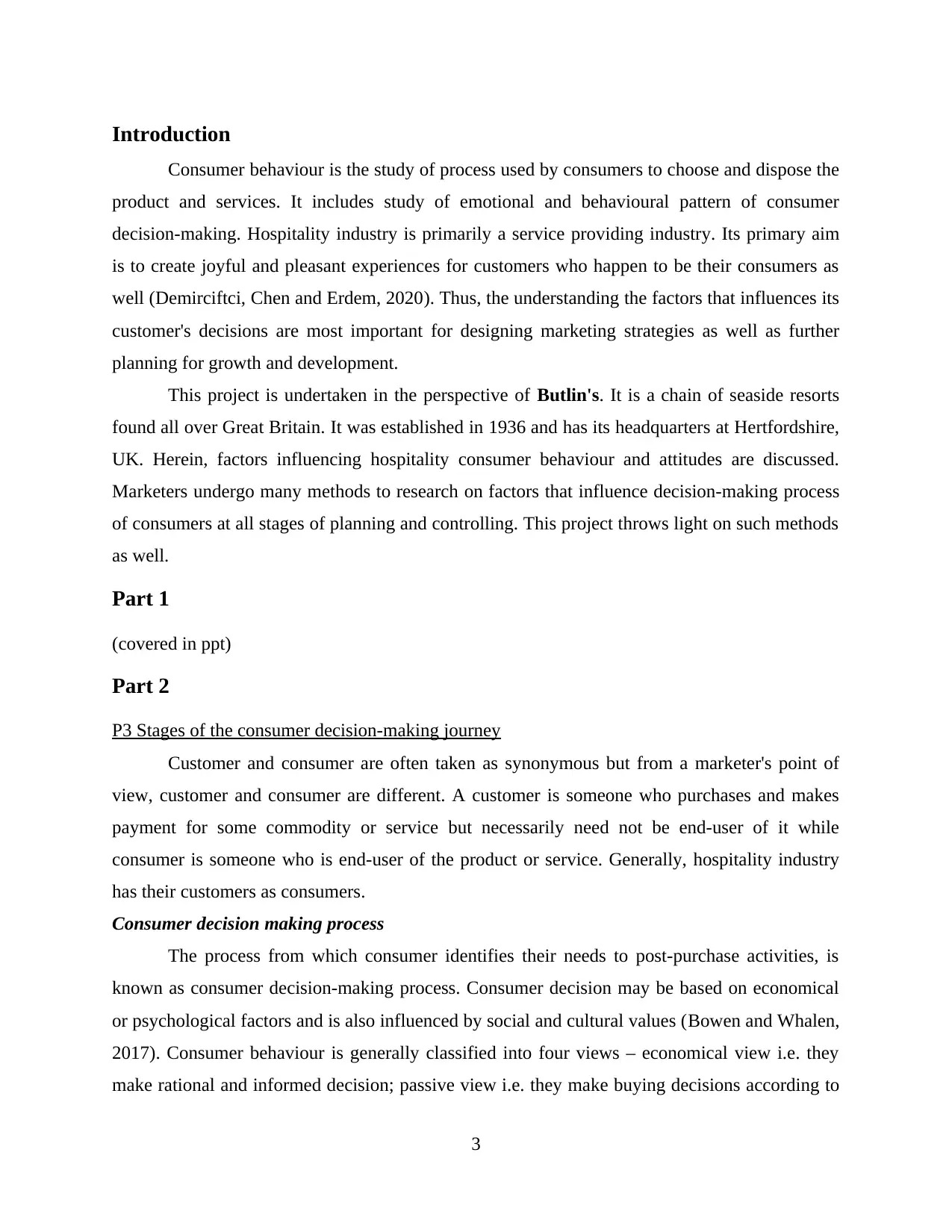
Introduction
Consumer behaviour is the study of process used by consumers to choose and dispose the
product and services. It includes study of emotional and behavioural pattern of consumer
decision-making. Hospitality industry is primarily a service providing industry. Its primary aim
is to create joyful and pleasant experiences for customers who happen to be their consumers as
well (Demirciftci, Chen and Erdem, 2020). Thus, the understanding the factors that influences its
customer's decisions are most important for designing marketing strategies as well as further
planning for growth and development.
This project is undertaken in the perspective of Butlin's. It is a chain of seaside resorts
found all over Great Britain. It was established in 1936 and has its headquarters at Hertfordshire,
UK. Herein, factors influencing hospitality consumer behaviour and attitudes are discussed.
Marketers undergo many methods to research on factors that influence decision-making process
of consumers at all stages of planning and controlling. This project throws light on such methods
as well.
Part 1
(covered in ppt)
Part 2
P3 Stages of the consumer decision-making journey
Customer and consumer are often taken as synonymous but from a marketer's point of
view, customer and consumer are different. A customer is someone who purchases and makes
payment for some commodity or service but necessarily need not be end-user of it while
consumer is someone who is end-user of the product or service. Generally, hospitality industry
has their customers as consumers.
Consumer decision making process
The process from which consumer identifies their needs to post-purchase activities, is
known as consumer decision-making process. Consumer decision may be based on economical
or psychological factors and is also influenced by social and cultural values (Bowen and Whalen,
2017). Consumer behaviour is generally classified into four views – economical view i.e. they
make rational and informed decision; passive view i.e. they make buying decisions according to
3
Consumer behaviour is the study of process used by consumers to choose and dispose the
product and services. It includes study of emotional and behavioural pattern of consumer
decision-making. Hospitality industry is primarily a service providing industry. Its primary aim
is to create joyful and pleasant experiences for customers who happen to be their consumers as
well (Demirciftci, Chen and Erdem, 2020). Thus, the understanding the factors that influences its
customer's decisions are most important for designing marketing strategies as well as further
planning for growth and development.
This project is undertaken in the perspective of Butlin's. It is a chain of seaside resorts
found all over Great Britain. It was established in 1936 and has its headquarters at Hertfordshire,
UK. Herein, factors influencing hospitality consumer behaviour and attitudes are discussed.
Marketers undergo many methods to research on factors that influence decision-making process
of consumers at all stages of planning and controlling. This project throws light on such methods
as well.
Part 1
(covered in ppt)
Part 2
P3 Stages of the consumer decision-making journey
Customer and consumer are often taken as synonymous but from a marketer's point of
view, customer and consumer are different. A customer is someone who purchases and makes
payment for some commodity or service but necessarily need not be end-user of it while
consumer is someone who is end-user of the product or service. Generally, hospitality industry
has their customers as consumers.
Consumer decision making process
The process from which consumer identifies their needs to post-purchase activities, is
known as consumer decision-making process. Consumer decision may be based on economical
or psychological factors and is also influenced by social and cultural values (Bowen and Whalen,
2017). Consumer behaviour is generally classified into four views – economical view i.e. they
make rational and informed decision; passive view i.e. they make buying decisions according to
3
⊘ This is a preview!⊘
Do you want full access?
Subscribe today to unlock all pages.

Trusted by 1+ million students worldwide
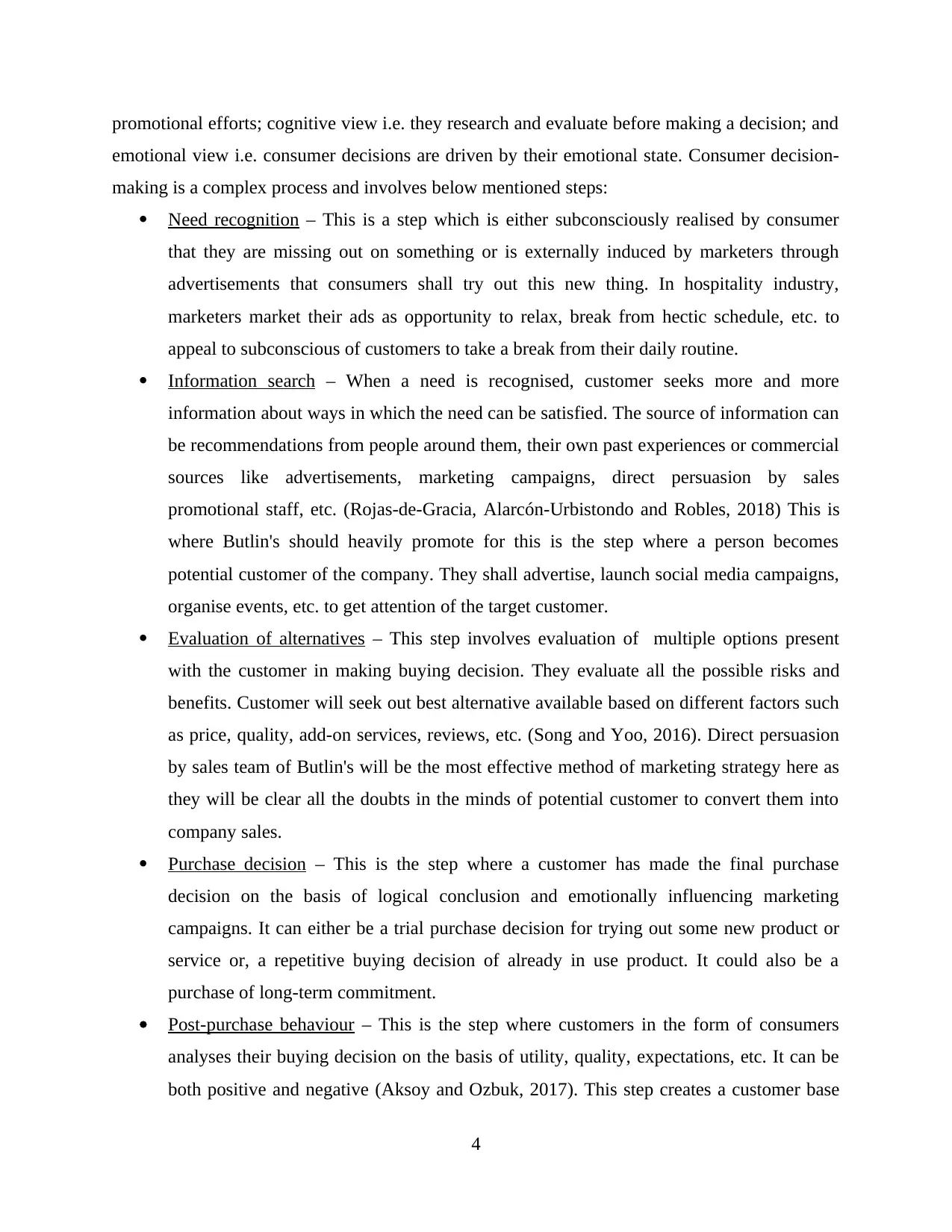
promotional efforts; cognitive view i.e. they research and evaluate before making a decision; and
emotional view i.e. consumer decisions are driven by their emotional state. Consumer decision-
making is a complex process and involves below mentioned steps:
Need recognition – This is a step which is either subconsciously realised by consumer
that they are missing out on something or is externally induced by marketers through
advertisements that consumers shall try out this new thing. In hospitality industry,
marketers market their ads as opportunity to relax, break from hectic schedule, etc. to
appeal to subconscious of customers to take a break from their daily routine.
Information search – When a need is recognised, customer seeks more and more
information about ways in which the need can be satisfied. The source of information can
be recommendations from people around them, their own past experiences or commercial
sources like advertisements, marketing campaigns, direct persuasion by sales
promotional staff, etc. (Rojas-de-Gracia, Alarcón-Urbistondo and Robles, 2018) This is
where Butlin's should heavily promote for this is the step where a person becomes
potential customer of the company. They shall advertise, launch social media campaigns,
organise events, etc. to get attention of the target customer.
Evaluation of alternatives – This step involves evaluation of multiple options present
with the customer in making buying decision. They evaluate all the possible risks and
benefits. Customer will seek out best alternative available based on different factors such
as price, quality, add-on services, reviews, etc. (Song and Yoo, 2016). Direct persuasion
by sales team of Butlin's will be the most effective method of marketing strategy here as
they will be clear all the doubts in the minds of potential customer to convert them into
company sales.
Purchase decision – This is the step where a customer has made the final purchase
decision on the basis of logical conclusion and emotionally influencing marketing
campaigns. It can either be a trial purchase decision for trying out some new product or
service or, a repetitive buying decision of already in use product. It could also be a
purchase of long-term commitment.
Post-purchase behaviour – This is the step where customers in the form of consumers
analyses their buying decision on the basis of utility, quality, expectations, etc. It can be
both positive and negative (Aksoy and Ozbuk, 2017). This step creates a customer base
4
emotional view i.e. consumer decisions are driven by their emotional state. Consumer decision-
making is a complex process and involves below mentioned steps:
Need recognition – This is a step which is either subconsciously realised by consumer
that they are missing out on something or is externally induced by marketers through
advertisements that consumers shall try out this new thing. In hospitality industry,
marketers market their ads as opportunity to relax, break from hectic schedule, etc. to
appeal to subconscious of customers to take a break from their daily routine.
Information search – When a need is recognised, customer seeks more and more
information about ways in which the need can be satisfied. The source of information can
be recommendations from people around them, their own past experiences or commercial
sources like advertisements, marketing campaigns, direct persuasion by sales
promotional staff, etc. (Rojas-de-Gracia, Alarcón-Urbistondo and Robles, 2018) This is
where Butlin's should heavily promote for this is the step where a person becomes
potential customer of the company. They shall advertise, launch social media campaigns,
organise events, etc. to get attention of the target customer.
Evaluation of alternatives – This step involves evaluation of multiple options present
with the customer in making buying decision. They evaluate all the possible risks and
benefits. Customer will seek out best alternative available based on different factors such
as price, quality, add-on services, reviews, etc. (Song and Yoo, 2016). Direct persuasion
by sales team of Butlin's will be the most effective method of marketing strategy here as
they will be clear all the doubts in the minds of potential customer to convert them into
company sales.
Purchase decision – This is the step where a customer has made the final purchase
decision on the basis of logical conclusion and emotionally influencing marketing
campaigns. It can either be a trial purchase decision for trying out some new product or
service or, a repetitive buying decision of already in use product. It could also be a
purchase of long-term commitment.
Post-purchase behaviour – This is the step where customers in the form of consumers
analyses their buying decision on the basis of utility, quality, expectations, etc. It can be
both positive and negative (Aksoy and Ozbuk, 2017). This step creates a customer base
4
Paraphrase This Document
Need a fresh take? Get an instant paraphrase of this document with our AI Paraphraser
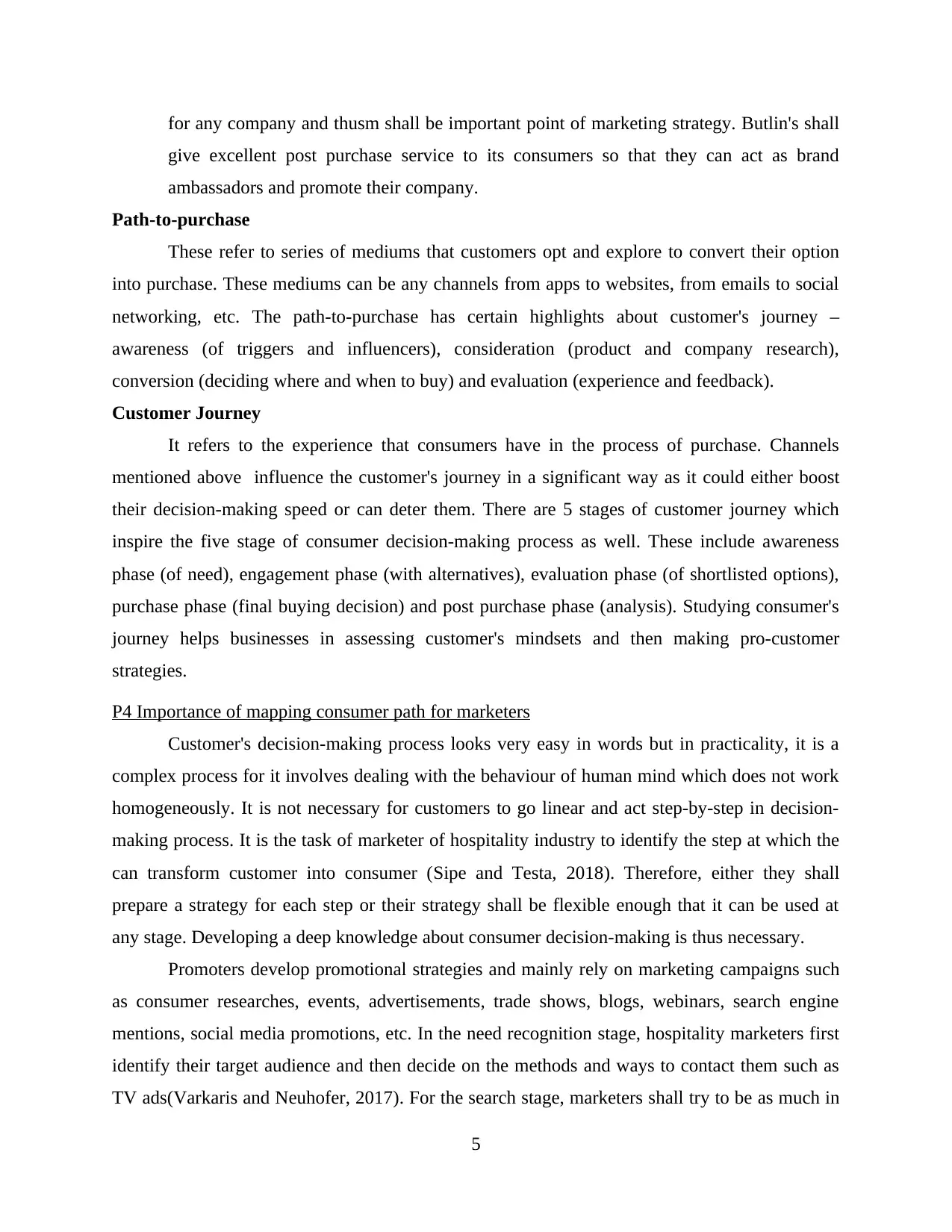
for any company and thusm shall be important point of marketing strategy. Butlin's shall
give excellent post purchase service to its consumers so that they can act as brand
ambassadors and promote their company.
Path-to-purchase
These refer to series of mediums that customers opt and explore to convert their option
into purchase. These mediums can be any channels from apps to websites, from emails to social
networking, etc. The path-to-purchase has certain highlights about customer's journey –
awareness (of triggers and influencers), consideration (product and company research),
conversion (deciding where and when to buy) and evaluation (experience and feedback).
Customer Journey
It refers to the experience that consumers have in the process of purchase. Channels
mentioned above influence the customer's journey in a significant way as it could either boost
their decision-making speed or can deter them. There are 5 stages of customer journey which
inspire the five stage of consumer decision-making process as well. These include awareness
phase (of need), engagement phase (with alternatives), evaluation phase (of shortlisted options),
purchase phase (final buying decision) and post purchase phase (analysis). Studying consumer's
journey helps businesses in assessing customer's mindsets and then making pro-customer
strategies.
P4 Importance of mapping consumer path for marketers
Customer's decision-making process looks very easy in words but in practicality, it is a
complex process for it involves dealing with the behaviour of human mind which does not work
homogeneously. It is not necessary for customers to go linear and act step-by-step in decision-
making process. It is the task of marketer of hospitality industry to identify the step at which the
can transform customer into consumer (Sipe and Testa, 2018). Therefore, either they shall
prepare a strategy for each step or their strategy shall be flexible enough that it can be used at
any stage. Developing a deep knowledge about consumer decision-making is thus necessary.
Promoters develop promotional strategies and mainly rely on marketing campaigns such
as consumer researches, events, advertisements, trade shows, blogs, webinars, search engine
mentions, social media promotions, etc. In the need recognition stage, hospitality marketers first
identify their target audience and then decide on the methods and ways to contact them such as
TV ads(Varkaris and Neuhofer, 2017). For the search stage, marketers shall try to be as much in
5
give excellent post purchase service to its consumers so that they can act as brand
ambassadors and promote their company.
Path-to-purchase
These refer to series of mediums that customers opt and explore to convert their option
into purchase. These mediums can be any channels from apps to websites, from emails to social
networking, etc. The path-to-purchase has certain highlights about customer's journey –
awareness (of triggers and influencers), consideration (product and company research),
conversion (deciding where and when to buy) and evaluation (experience and feedback).
Customer Journey
It refers to the experience that consumers have in the process of purchase. Channels
mentioned above influence the customer's journey in a significant way as it could either boost
their decision-making speed or can deter them. There are 5 stages of customer journey which
inspire the five stage of consumer decision-making process as well. These include awareness
phase (of need), engagement phase (with alternatives), evaluation phase (of shortlisted options),
purchase phase (final buying decision) and post purchase phase (analysis). Studying consumer's
journey helps businesses in assessing customer's mindsets and then making pro-customer
strategies.
P4 Importance of mapping consumer path for marketers
Customer's decision-making process looks very easy in words but in practicality, it is a
complex process for it involves dealing with the behaviour of human mind which does not work
homogeneously. It is not necessary for customers to go linear and act step-by-step in decision-
making process. It is the task of marketer of hospitality industry to identify the step at which the
can transform customer into consumer (Sipe and Testa, 2018). Therefore, either they shall
prepare a strategy for each step or their strategy shall be flexible enough that it can be used at
any stage. Developing a deep knowledge about consumer decision-making is thus necessary.
Promoters develop promotional strategies and mainly rely on marketing campaigns such
as consumer researches, events, advertisements, trade shows, blogs, webinars, search engine
mentions, social media promotions, etc. In the need recognition stage, hospitality marketers first
identify their target audience and then decide on the methods and ways to contact them such as
TV ads(Varkaris and Neuhofer, 2017). For the search stage, marketers shall try to be as much in
5
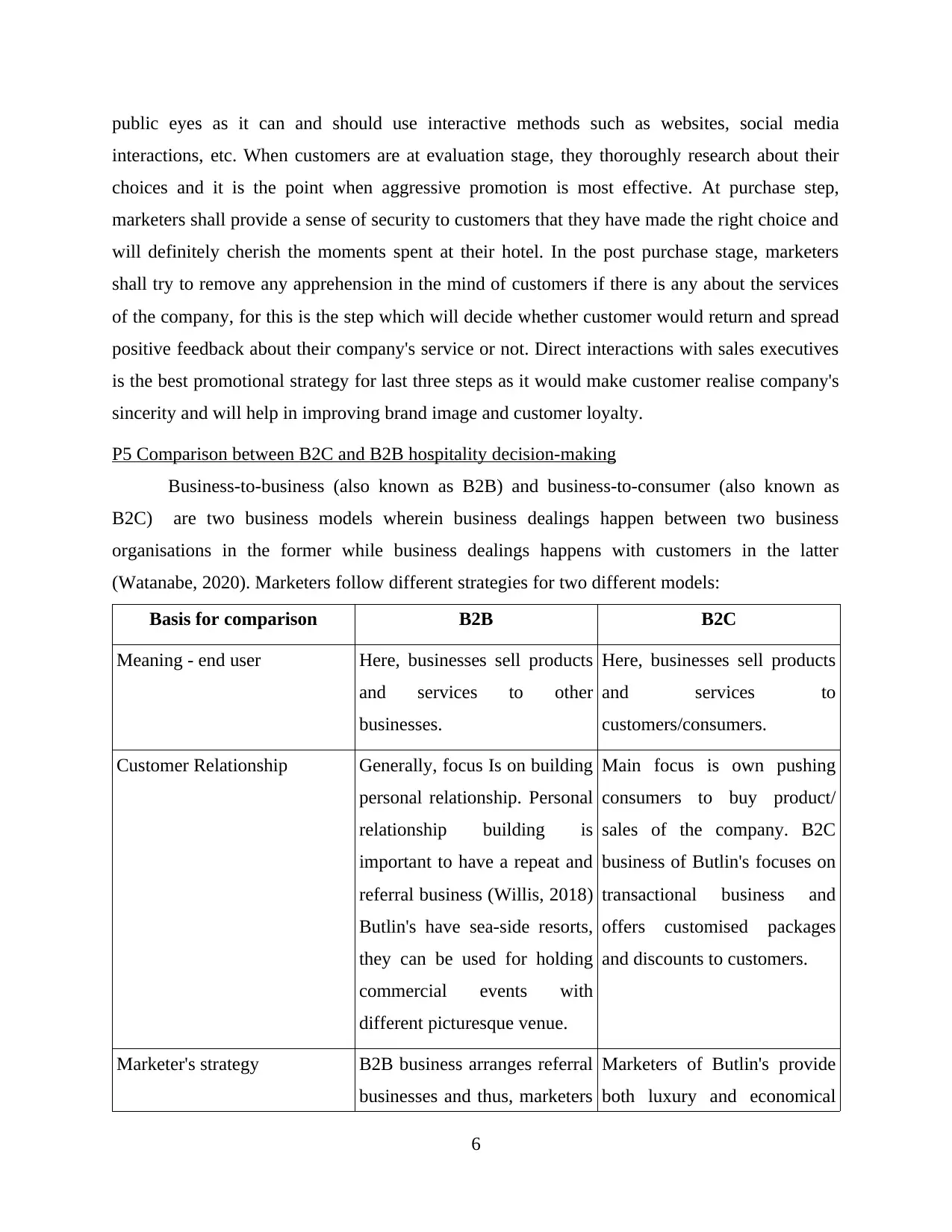
public eyes as it can and should use interactive methods such as websites, social media
interactions, etc. When customers are at evaluation stage, they thoroughly research about their
choices and it is the point when aggressive promotion is most effective. At purchase step,
marketers shall provide a sense of security to customers that they have made the right choice and
will definitely cherish the moments spent at their hotel. In the post purchase stage, marketers
shall try to remove any apprehension in the mind of customers if there is any about the services
of the company, for this is the step which will decide whether customer would return and spread
positive feedback about their company's service or not. Direct interactions with sales executives
is the best promotional strategy for last three steps as it would make customer realise company's
sincerity and will help in improving brand image and customer loyalty.
P5 Comparison between B2C and B2B hospitality decision-making
Business-to-business (also known as B2B) and business-to-consumer (also known as
B2C) are two business models wherein business dealings happen between two business
organisations in the former while business dealings happens with customers in the latter
(Watanabe, 2020). Marketers follow different strategies for two different models:
Basis for comparison B2B B2C
Meaning - end user Here, businesses sell products
and services to other
businesses.
Here, businesses sell products
and services to
customers/consumers.
Customer Relationship Generally, focus Is on building
personal relationship. Personal
relationship building is
important to have a repeat and
referral business (Willis, 2018)
Butlin's have sea-side resorts,
they can be used for holding
commercial events with
different picturesque venue.
Main focus is own pushing
consumers to buy product/
sales of the company. B2C
business of Butlin's focuses on
transactional business and
offers customised packages
and discounts to customers.
Marketer's strategy B2B business arranges referral
businesses and thus, marketers
Marketers of Butlin's provide
both luxury and economical
6
interactions, etc. When customers are at evaluation stage, they thoroughly research about their
choices and it is the point when aggressive promotion is most effective. At purchase step,
marketers shall provide a sense of security to customers that they have made the right choice and
will definitely cherish the moments spent at their hotel. In the post purchase stage, marketers
shall try to remove any apprehension in the mind of customers if there is any about the services
of the company, for this is the step which will decide whether customer would return and spread
positive feedback about their company's service or not. Direct interactions with sales executives
is the best promotional strategy for last three steps as it would make customer realise company's
sincerity and will help in improving brand image and customer loyalty.
P5 Comparison between B2C and B2B hospitality decision-making
Business-to-business (also known as B2B) and business-to-consumer (also known as
B2C) are two business models wherein business dealings happen between two business
organisations in the former while business dealings happens with customers in the latter
(Watanabe, 2020). Marketers follow different strategies for two different models:
Basis for comparison B2B B2C
Meaning - end user Here, businesses sell products
and services to other
businesses.
Here, businesses sell products
and services to
customers/consumers.
Customer Relationship Generally, focus Is on building
personal relationship. Personal
relationship building is
important to have a repeat and
referral business (Willis, 2018)
Butlin's have sea-side resorts,
they can be used for holding
commercial events with
different picturesque venue.
Main focus is own pushing
consumers to buy product/
sales of the company. B2C
business of Butlin's focuses on
transactional business and
offers customised packages
and discounts to customers.
Marketer's strategy B2B business arranges referral
businesses and thus, marketers
Marketers of Butlin's provide
both luxury and economical
6
⊘ This is a preview!⊘
Do you want full access?
Subscribe today to unlock all pages.

Trusted by 1+ million students worldwide
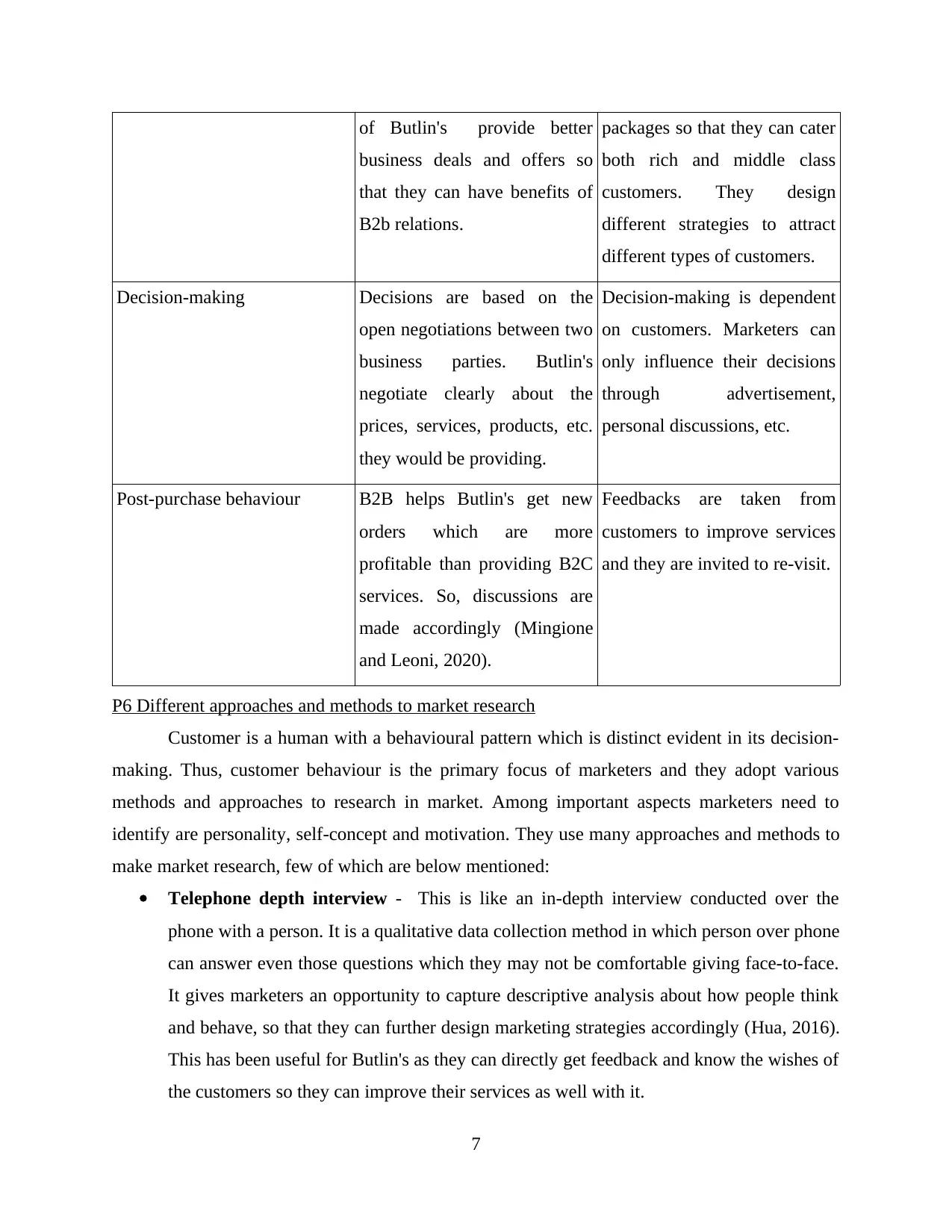
of Butlin's provide better
business deals and offers so
that they can have benefits of
B2b relations.
packages so that they can cater
both rich and middle class
customers. They design
different strategies to attract
different types of customers.
Decision-making Decisions are based on the
open negotiations between two
business parties. Butlin's
negotiate clearly about the
prices, services, products, etc.
they would be providing.
Decision-making is dependent
on customers. Marketers can
only influence their decisions
through advertisement,
personal discussions, etc.
Post-purchase behaviour B2B helps Butlin's get new
orders which are more
profitable than providing B2C
services. So, discussions are
made accordingly (Mingione
and Leoni, 2020).
Feedbacks are taken from
customers to improve services
and they are invited to re-visit.
P6 Different approaches and methods to market research
Customer is a human with a behavioural pattern which is distinct evident in its decision-
making. Thus, customer behaviour is the primary focus of marketers and they adopt various
methods and approaches to research in market. Among important aspects marketers need to
identify are personality, self-concept and motivation. They use many approaches and methods to
make market research, few of which are below mentioned:
Telephone depth interview - This is like an in-depth interview conducted over the
phone with a person. It is a qualitative data collection method in which person over phone
can answer even those questions which they may not be comfortable giving face-to-face.
It gives marketers an opportunity to capture descriptive analysis about how people think
and behave, so that they can further design marketing strategies accordingly (Hua, 2016).
This has been useful for Butlin's as they can directly get feedback and know the wishes of
the customers so they can improve their services as well with it.
7
business deals and offers so
that they can have benefits of
B2b relations.
packages so that they can cater
both rich and middle class
customers. They design
different strategies to attract
different types of customers.
Decision-making Decisions are based on the
open negotiations between two
business parties. Butlin's
negotiate clearly about the
prices, services, products, etc.
they would be providing.
Decision-making is dependent
on customers. Marketers can
only influence their decisions
through advertisement,
personal discussions, etc.
Post-purchase behaviour B2B helps Butlin's get new
orders which are more
profitable than providing B2C
services. So, discussions are
made accordingly (Mingione
and Leoni, 2020).
Feedbacks are taken from
customers to improve services
and they are invited to re-visit.
P6 Different approaches and methods to market research
Customer is a human with a behavioural pattern which is distinct evident in its decision-
making. Thus, customer behaviour is the primary focus of marketers and they adopt various
methods and approaches to research in market. Among important aspects marketers need to
identify are personality, self-concept and motivation. They use many approaches and methods to
make market research, few of which are below mentioned:
Telephone depth interview - This is like an in-depth interview conducted over the
phone with a person. It is a qualitative data collection method in which person over phone
can answer even those questions which they may not be comfortable giving face-to-face.
It gives marketers an opportunity to capture descriptive analysis about how people think
and behave, so that they can further design marketing strategies accordingly (Hua, 2016).
This has been useful for Butlin's as they can directly get feedback and know the wishes of
the customers so they can improve their services as well with it.
7
Paraphrase This Document
Need a fresh take? Get an instant paraphrase of this document with our AI Paraphraser
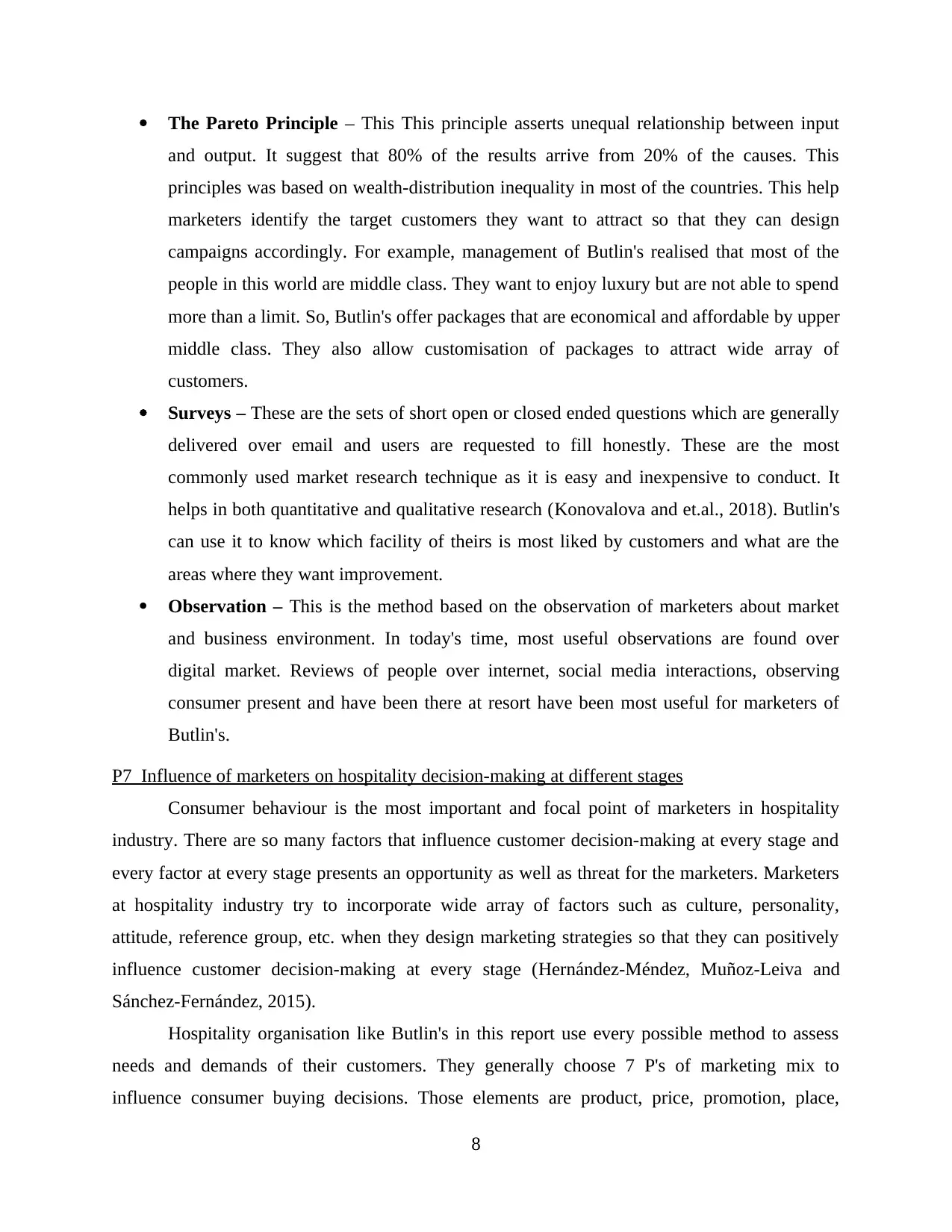
The Pareto Principle – This This principle asserts unequal relationship between input
and output. It suggest that 80% of the results arrive from 20% of the causes. This
principles was based on wealth-distribution inequality in most of the countries. This help
marketers identify the target customers they want to attract so that they can design
campaigns accordingly. For example, management of Butlin's realised that most of the
people in this world are middle class. They want to enjoy luxury but are not able to spend
more than a limit. So, Butlin's offer packages that are economical and affordable by upper
middle class. They also allow customisation of packages to attract wide array of
customers.
Surveys – These are the sets of short open or closed ended questions which are generally
delivered over email and users are requested to fill honestly. These are the most
commonly used market research technique as it is easy and inexpensive to conduct. It
helps in both quantitative and qualitative research (Konovalova and et.al., 2018). Butlin's
can use it to know which facility of theirs is most liked by customers and what are the
areas where they want improvement.
Observation – This is the method based on the observation of marketers about market
and business environment. In today's time, most useful observations are found over
digital market. Reviews of people over internet, social media interactions, observing
consumer present and have been there at resort have been most useful for marketers of
Butlin's.
P7 Influence of marketers on hospitality decision-making at different stages
Consumer behaviour is the most important and focal point of marketers in hospitality
industry. There are so many factors that influence customer decision-making at every stage and
every factor at every stage presents an opportunity as well as threat for the marketers. Marketers
at hospitality industry try to incorporate wide array of factors such as culture, personality,
attitude, reference group, etc. when they design marketing strategies so that they can positively
influence customer decision-making at every stage (Hernández-Méndez, Muñoz-Leiva and
Sánchez-Fernández, 2015).
Hospitality organisation like Butlin's in this report use every possible method to assess
needs and demands of their customers. They generally choose 7 P's of marketing mix to
influence consumer buying decisions. Those elements are product, price, promotion, place,
8
and output. It suggest that 80% of the results arrive from 20% of the causes. This
principles was based on wealth-distribution inequality in most of the countries. This help
marketers identify the target customers they want to attract so that they can design
campaigns accordingly. For example, management of Butlin's realised that most of the
people in this world are middle class. They want to enjoy luxury but are not able to spend
more than a limit. So, Butlin's offer packages that are economical and affordable by upper
middle class. They also allow customisation of packages to attract wide array of
customers.
Surveys – These are the sets of short open or closed ended questions which are generally
delivered over email and users are requested to fill honestly. These are the most
commonly used market research technique as it is easy and inexpensive to conduct. It
helps in both quantitative and qualitative research (Konovalova and et.al., 2018). Butlin's
can use it to know which facility of theirs is most liked by customers and what are the
areas where they want improvement.
Observation – This is the method based on the observation of marketers about market
and business environment. In today's time, most useful observations are found over
digital market. Reviews of people over internet, social media interactions, observing
consumer present and have been there at resort have been most useful for marketers of
Butlin's.
P7 Influence of marketers on hospitality decision-making at different stages
Consumer behaviour is the most important and focal point of marketers in hospitality
industry. There are so many factors that influence customer decision-making at every stage and
every factor at every stage presents an opportunity as well as threat for the marketers. Marketers
at hospitality industry try to incorporate wide array of factors such as culture, personality,
attitude, reference group, etc. when they design marketing strategies so that they can positively
influence customer decision-making at every stage (Hernández-Méndez, Muñoz-Leiva and
Sánchez-Fernández, 2015).
Hospitality organisation like Butlin's in this report use every possible method to assess
needs and demands of their customers. They generally choose 7 P's of marketing mix to
influence consumer buying decisions. Those elements are product, price, promotion, place,
8
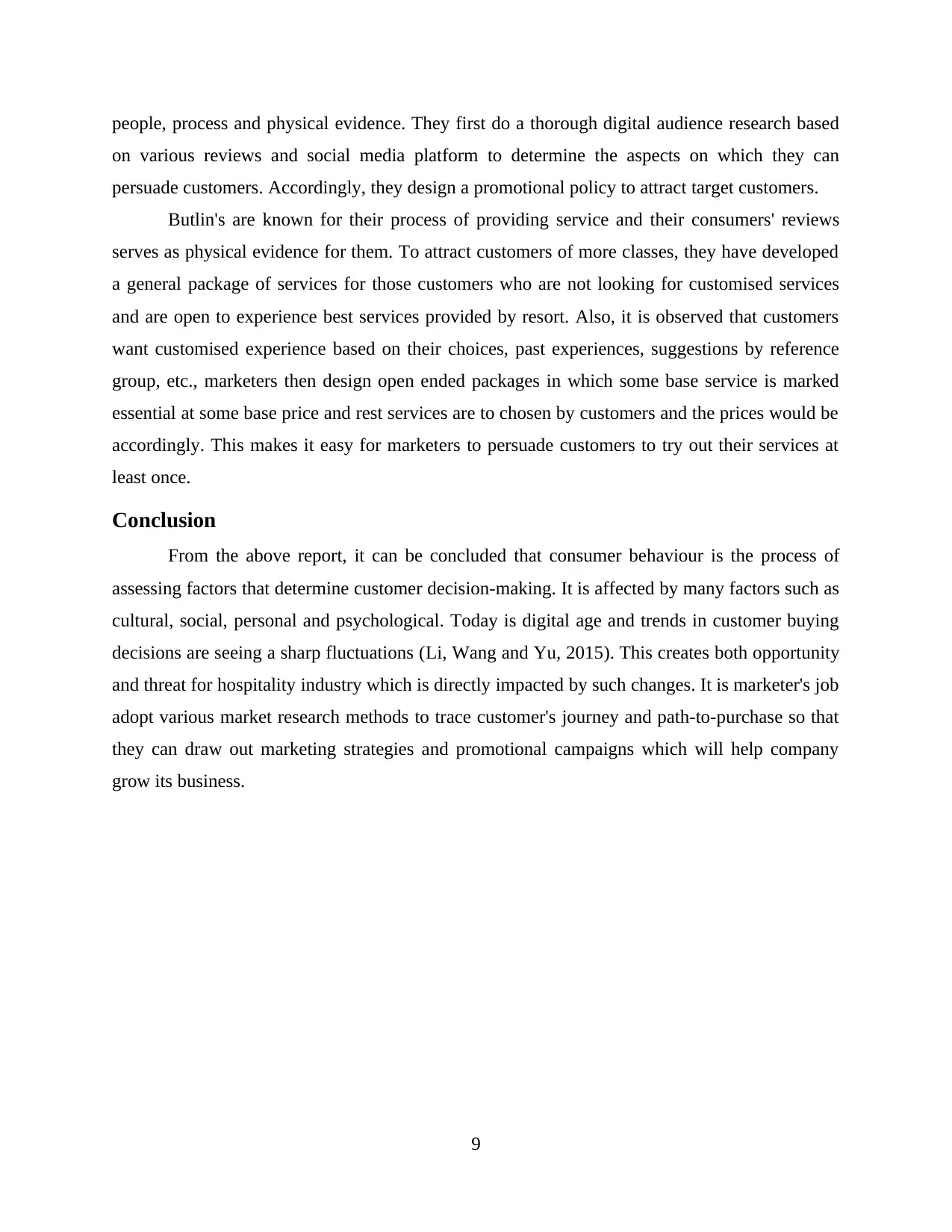
people, process and physical evidence. They first do a thorough digital audience research based
on various reviews and social media platform to determine the aspects on which they can
persuade customers. Accordingly, they design a promotional policy to attract target customers.
Butlin's are known for their process of providing service and their consumers' reviews
serves as physical evidence for them. To attract customers of more classes, they have developed
a general package of services for those customers who are not looking for customised services
and are open to experience best services provided by resort. Also, it is observed that customers
want customised experience based on their choices, past experiences, suggestions by reference
group, etc., marketers then design open ended packages in which some base service is marked
essential at some base price and rest services are to chosen by customers and the prices would be
accordingly. This makes it easy for marketers to persuade customers to try out their services at
least once.
Conclusion
From the above report, it can be concluded that consumer behaviour is the process of
assessing factors that determine customer decision-making. It is affected by many factors such as
cultural, social, personal and psychological. Today is digital age and trends in customer buying
decisions are seeing a sharp fluctuations (Li, Wang and Yu, 2015). This creates both opportunity
and threat for hospitality industry which is directly impacted by such changes. It is marketer's job
adopt various market research methods to trace customer's journey and path-to-purchase so that
they can draw out marketing strategies and promotional campaigns which will help company
grow its business.
9
on various reviews and social media platform to determine the aspects on which they can
persuade customers. Accordingly, they design a promotional policy to attract target customers.
Butlin's are known for their process of providing service and their consumers' reviews
serves as physical evidence for them. To attract customers of more classes, they have developed
a general package of services for those customers who are not looking for customised services
and are open to experience best services provided by resort. Also, it is observed that customers
want customised experience based on their choices, past experiences, suggestions by reference
group, etc., marketers then design open ended packages in which some base service is marked
essential at some base price and rest services are to chosen by customers and the prices would be
accordingly. This makes it easy for marketers to persuade customers to try out their services at
least once.
Conclusion
From the above report, it can be concluded that consumer behaviour is the process of
assessing factors that determine customer decision-making. It is affected by many factors such as
cultural, social, personal and psychological. Today is digital age and trends in customer buying
decisions are seeing a sharp fluctuations (Li, Wang and Yu, 2015). This creates both opportunity
and threat for hospitality industry which is directly impacted by such changes. It is marketer's job
adopt various market research methods to trace customer's journey and path-to-purchase so that
they can draw out marketing strategies and promotional campaigns which will help company
grow its business.
9
⊘ This is a preview!⊘
Do you want full access?
Subscribe today to unlock all pages.

Trusted by 1+ million students worldwide
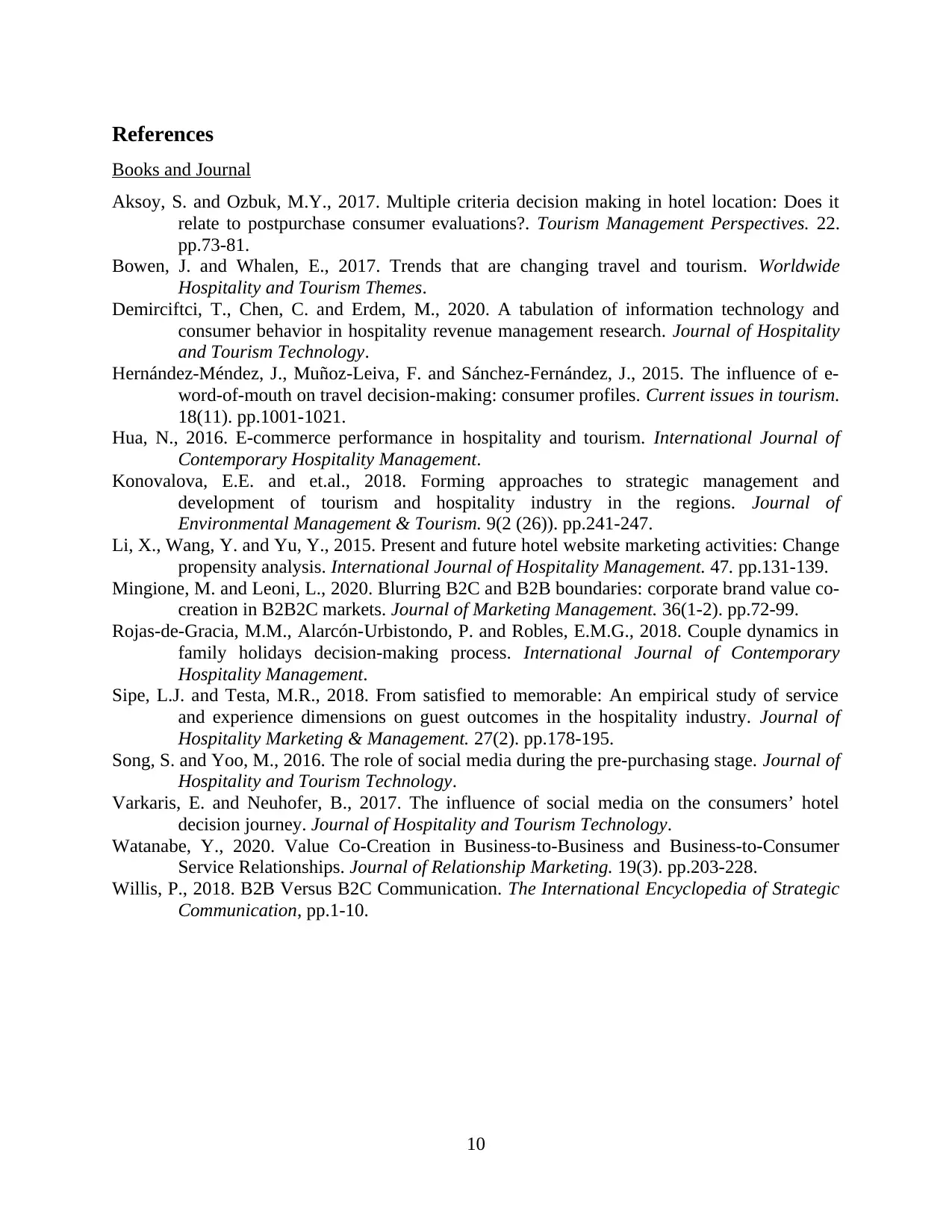
References
Books and Journal
Aksoy, S. and Ozbuk, M.Y., 2017. Multiple criteria decision making in hotel location: Does it
relate to postpurchase consumer evaluations?. Tourism Management Perspectives. 22.
pp.73-81.
Bowen, J. and Whalen, E., 2017. Trends that are changing travel and tourism. Worldwide
Hospitality and Tourism Themes.
Demirciftci, T., Chen, C. and Erdem, M., 2020. A tabulation of information technology and
consumer behavior in hospitality revenue management research. Journal of Hospitality
and Tourism Technology.
Hernández-Méndez, J., Muñoz-Leiva, F. and Sánchez-Fernández, J., 2015. The influence of e-
word-of-mouth on travel decision-making: consumer profiles. Current issues in tourism.
18(11). pp.1001-1021.
Hua, N., 2016. E-commerce performance in hospitality and tourism. International Journal of
Contemporary Hospitality Management.
Konovalova, E.E. and et.al., 2018. Forming approaches to strategic management and
development of tourism and hospitality industry in the regions. Journal of
Environmental Management & Tourism. 9(2 (26)). pp.241-247.
Li, X., Wang, Y. and Yu, Y., 2015. Present and future hotel website marketing activities: Change
propensity analysis. International Journal of Hospitality Management. 47. pp.131-139.
Mingione, M. and Leoni, L., 2020. Blurring B2C and B2B boundaries: corporate brand value co-
creation in B2B2C markets. Journal of Marketing Management. 36(1-2). pp.72-99.
Rojas-de-Gracia, M.M., Alarcón-Urbistondo, P. and Robles, E.M.G., 2018. Couple dynamics in
family holidays decision-making process. International Journal of Contemporary
Hospitality Management.
Sipe, L.J. and Testa, M.R., 2018. From satisfied to memorable: An empirical study of service
and experience dimensions on guest outcomes in the hospitality industry. Journal of
Hospitality Marketing & Management. 27(2). pp.178-195.
Song, S. and Yoo, M., 2016. The role of social media during the pre-purchasing stage. Journal of
Hospitality and Tourism Technology.
Varkaris, E. and Neuhofer, B., 2017. The influence of social media on the consumers’ hotel
decision journey. Journal of Hospitality and Tourism Technology.
Watanabe, Y., 2020. Value Co-Creation in Business-to-Business and Business-to-Consumer
Service Relationships. Journal of Relationship Marketing. 19(3). pp.203-228.
Willis, P., 2018. B2B Versus B2C Communication. The International Encyclopedia of Strategic
Communication, pp.1-10.
10
Books and Journal
Aksoy, S. and Ozbuk, M.Y., 2017. Multiple criteria decision making in hotel location: Does it
relate to postpurchase consumer evaluations?. Tourism Management Perspectives. 22.
pp.73-81.
Bowen, J. and Whalen, E., 2017. Trends that are changing travel and tourism. Worldwide
Hospitality and Tourism Themes.
Demirciftci, T., Chen, C. and Erdem, M., 2020. A tabulation of information technology and
consumer behavior in hospitality revenue management research. Journal of Hospitality
and Tourism Technology.
Hernández-Méndez, J., Muñoz-Leiva, F. and Sánchez-Fernández, J., 2015. The influence of e-
word-of-mouth on travel decision-making: consumer profiles. Current issues in tourism.
18(11). pp.1001-1021.
Hua, N., 2016. E-commerce performance in hospitality and tourism. International Journal of
Contemporary Hospitality Management.
Konovalova, E.E. and et.al., 2018. Forming approaches to strategic management and
development of tourism and hospitality industry in the regions. Journal of
Environmental Management & Tourism. 9(2 (26)). pp.241-247.
Li, X., Wang, Y. and Yu, Y., 2015. Present and future hotel website marketing activities: Change
propensity analysis. International Journal of Hospitality Management. 47. pp.131-139.
Mingione, M. and Leoni, L., 2020. Blurring B2C and B2B boundaries: corporate brand value co-
creation in B2B2C markets. Journal of Marketing Management. 36(1-2). pp.72-99.
Rojas-de-Gracia, M.M., Alarcón-Urbistondo, P. and Robles, E.M.G., 2018. Couple dynamics in
family holidays decision-making process. International Journal of Contemporary
Hospitality Management.
Sipe, L.J. and Testa, M.R., 2018. From satisfied to memorable: An empirical study of service
and experience dimensions on guest outcomes in the hospitality industry. Journal of
Hospitality Marketing & Management. 27(2). pp.178-195.
Song, S. and Yoo, M., 2016. The role of social media during the pre-purchasing stage. Journal of
Hospitality and Tourism Technology.
Varkaris, E. and Neuhofer, B., 2017. The influence of social media on the consumers’ hotel
decision journey. Journal of Hospitality and Tourism Technology.
Watanabe, Y., 2020. Value Co-Creation in Business-to-Business and Business-to-Consumer
Service Relationships. Journal of Relationship Marketing. 19(3). pp.203-228.
Willis, P., 2018. B2B Versus B2C Communication. The International Encyclopedia of Strategic
Communication, pp.1-10.
10
1 out of 10
Related Documents
Your All-in-One AI-Powered Toolkit for Academic Success.
+13062052269
info@desklib.com
Available 24*7 on WhatsApp / Email
![[object Object]](/_next/static/media/star-bottom.7253800d.svg)
Unlock your academic potential
Copyright © 2020–2025 A2Z Services. All Rights Reserved. Developed and managed by ZUCOL.





